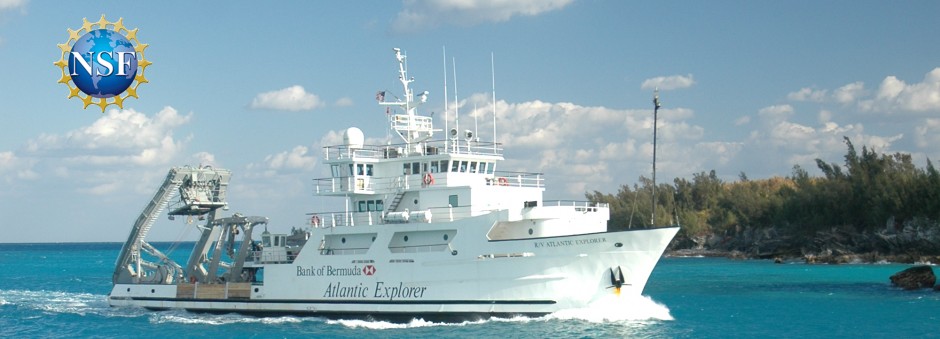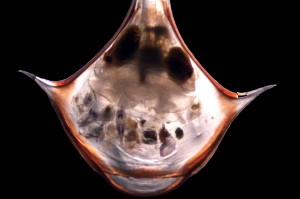Seawater is teeming with microscopic life – a weird, wild, underwater zoo. There are gelatinous blobby creatures, animals with tiny legs and claw-like appendages, and organisms so strange-looking that they could have come straight out of an alien movie, except most of these creatures are no bigger than a grain of rice. Many of the scientists on board are studying these micro-organisms, collectively known as plankton. To catch them, we draw a net through the water, similar to the way you can pull a butterfly net through the air to catch insects. My plankton net is taller than I am, and before I cast it into the sea I attach it to large wire reel called a winch. The winch operator then slowly turns the reel and lowers the net into the water, and we pull it gently behind the ship for a few minutes. Sometimes, a wave will wash onto the deck and soak us as we’re working (see photo below).
When the net comes back, the bottle on the end of the net is full of plankton – it looks like a green-brown soup, full of tiny darting, wriggling things. We carefully unhook the net and take the bottle quickly to the lab, where we can see what we got. That is the most exciting moment for me – that first look through the microscope into an alien world, full of strange things. A lot of plankton have clear bodies, and you can see their organs inside. Some are bright colors, like orange or blue; some are even iridescent or glowing. Sometimes I see organisms eating each other, or stuck to each other. I would not want to be caught in a plankton tow myself … I imagine it would be like someone dragging a giant soccer net down the sidewalks of New York city for a while, collecting people and dogs and food trucks and trash cans all into a great big pile.
The scientists studying plankton on this ship are all looking for different kinds – copepods, which look like insects, pteropods, which sometimes look like snails with wings, and many more. I am collecting foraminifera, single-celled organisms that float through the water, catching food on long, gooey tentacle-like appendages called pseudopodia. They will eat almost anything that comes their way, and they can even catch and devour things that are larger than themselves. Foraminifera grow shells made of calcite (the shells look like miniature popcorn), and when they die, their shells sink. The sea floor is covered in these shells, which have been slowly accumulating for millions of years. If I can understand the relationship between the chemistry of these shells and the water in which they grew, I can apply that information to fossil shells and ultimately figure out what past oceans were like. In this way, we can trace the history of the ocean beyond the times covered by written historical records, before humans even walked the planet.
Blog Post Contributed by Kat Allen, pteropod photo by Paul Suprenand.
P.s. We’ve posted some more replies to the questions and comments left on our first post. go check them out!



Justin Haag- What kind of things do you look for when measuring the camouflage of deep sea creatures/ what are you measuring? Also where did you go to college?
A nice way to think of the biological camouflage problem is to start by considering a particular animal, and imagine what it must do to survive in its environment. In particular, three things are most important: finding food, finding mates, and avoiding predation. For my work, I’ve chosen to focus on predation aversion, and two particular aspects of this: physical appearance and the ambient light field. I previously built an instrument to measure how light is scattered from the skin of a few deep sea species of mirrored squid and fish. These measurements provide us with a quantitative understanding of the appearance of some of the animals that live in these parts of the ocean. More recently, I built two highly-sensitive radiometers that measure a quantity called `downwelling irradiance’ which can be thought of as the light that is falling downward (from the surface) in the ocean. These are the instruments that I brought with me on the CST cruise. I am interested to see what the downwelling irradiance looks like at up to 500 meters deep in the ocean, as we have many models, but few measurements at these depths. I hope that with the combination of information from animal appearance and an improved idea of what the deep sea habitats look like, we can discover some of nature’s strategies for deep sea biological camouflage.
My undergraduate degree was in physics, which I received from Northern Illinois University. For studies such as the one I described, where novel technology is applied to solving interesting biological problems, I think the most important thing is to obtain a diverse education. You should consider taking classes in all areas of science and engineering, regardless of your major. Having more tools in your toolbox will allow you to bring a unique perspective to any problem you encounter.
-Justin
How are you going to study the foraminifera glow shells…. with what equipment????
The shells of foraminifera are made of calcium carbonate (calcium, carbon, oxygen, and very small amounts of some other elements). The first measurements I make are very simple — length and weight of each shell. The shells are usually less than a millimeter long and weigh a small fraction of a milligram, so I have to be careful. One time I sneezed and lost a foram. Next, I clean the calcite shells by rinsing them several times to remove fine particles. Then, I clean them with oxidative chemicals (that will remove organic matter) and reductive chemicals (that will remove any contaminating metal oxides). Finally, I crush the shells and dissolve them (this is the most stressful step! I hate watching my sample disappear, even though it is a planned part of the procedure). Once the sample is dissolved, I run it through an instrument called a mass spectrometer, which can determine the elemental composition of the sample. This information is really useful because it tells us about the environment in which the forams lived. For example, the warmer the water, the higher the ratio of magnesium to calcium in the shells. We can apply these relationships (called proxies) to modern samples and also to fossil samples. In this way, we can figure out the ocean’s temperature history, which is very useful to understanding evolution of marine organisms as well as quantifying past climate change.
–Kat Allen
How do you think aerosols affect our climate ?
Steve Techtmann:
Once you grow the DNA and RNA of this bacteria will you expose to oil to see how it will react… as it does in the ocean?
why do Foraminifera shells sink when they die?
What made you want to research about the microscopic zoo?
What is the most interesting/amazing type of Plankton?
Hi Liam,
Many planktonic animals are really amazing. They have elaborate shapes and various adaptations for feeding. For example, some copepods (small crustaceans) have brush-like appendages to collect small particles as food while others have big maxillipeds and are predators. One type of copepod has turquoise-colored eggs that they carry beneath their body. Another copepod has black and white stripes. Another type is flat and blue and lives near the sea surface. Their adaptations and behavior are always amazing. Karen W
When you said you could figure out what past oceans would be like do you think you will find at least 50 new species?